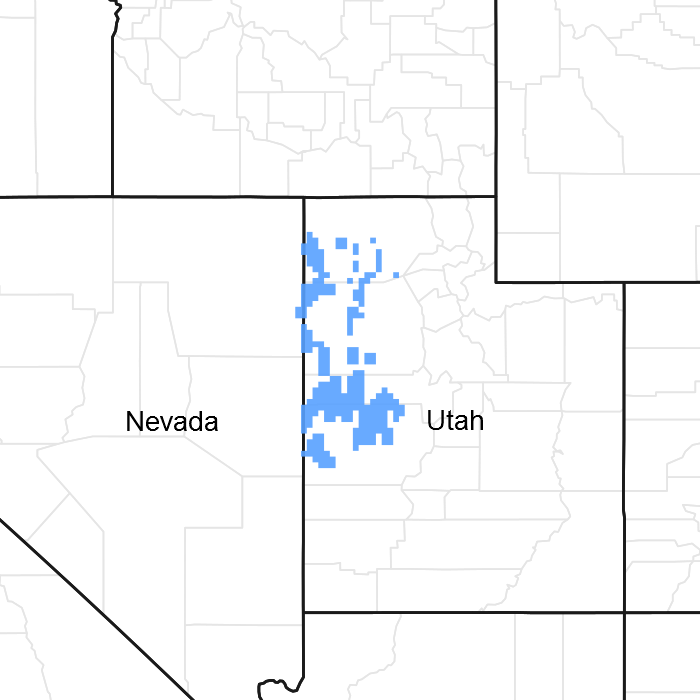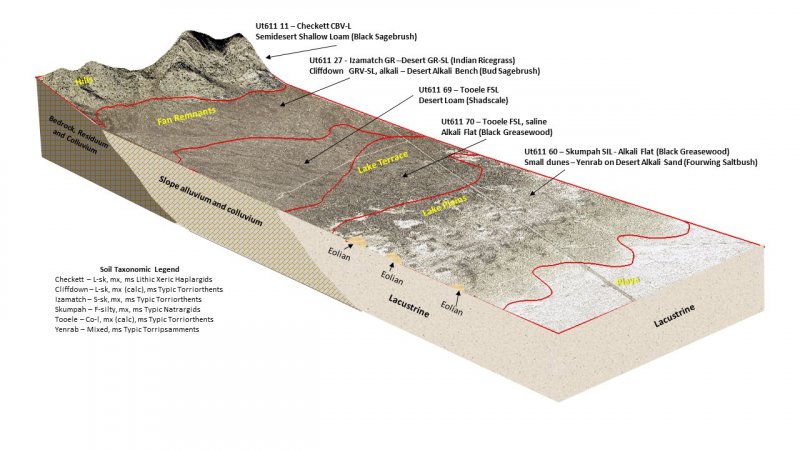Ecological dynamics
As ecological condition deteriorates due to overgrazing, galleta, squirreltail, and Indian ricegrass decrease while snakeweed, horsebrush, and rabbitbrush increase.
When the potential natural plant community is burned, Indian ricegrass and galleta decrease while low rabbitbrush, horsebrush, and cheatgrass increase.
Annual forbs and annual grasses are most likely to invade this site.
This site is similar in soils and vegetation composition to 028AY016NV. The STM developed by Nevada (Stringham et al. 2015) is used for the Utah ESD.
State 1
Reference State
The Reference State 1.0 is a representative of the natural range of variability under pristine conditions. The Reference State has two general community phases: a shrub-grass dominate phase and a shrub dominant phase. State dynamics are maintained by interactions between climatic patterns and disturbance regimes. Negative feedbacks enhance ecosystem resilience and contribute to the stability of the state. These include the presence of all structural and functional groups, low fine fuel loads, and retention of organic matter and nutrients. This site is very stable, with little variation in plant community composition. Plant community changes would be reflected in production response to long term drought or herbivory. Wet years will increase grass production, while drought years will reduce production. Shrub production will also increase during wet years; however, extreme growing season wet periods has been shown to cause shadscale death.
Community 1.1
Bud sagebrush, shadscale, perennial grass
The dominant aspect of the plant community is bud sagebrush and shadscale. The composition by air dry weight is approximately 30 percent perennial grasses, 10 percent forbs, and 60 percent shrubs.
Table 5. Annual production by plant type
| Plant type |
Low
(lb/acre) |
Representative value
(lb/acre) |
High
(lb/acre) |
| Shrub/Vine |
30 |
120 |
150 |
| Grass/Grasslike |
15 |
60 |
75 |
| Forb |
5 |
20 |
25 |
| Total |
50 |
200 |
250 |
Table 6. Ground cover
| Tree foliar cover |
0%
|
| Shrub/vine/liana foliar cover |
15-30%
|
| Grass/grasslike foliar cover |
5-15%
|
| Forb foliar cover |
3-5%
|
| Non-vascular plants |
0%
|
| Biological crusts |
0%
|
| Litter |
0%
|
| Surface fragments >0.25" and <=3" |
0%
|
| Surface fragments >3" |
0%
|
| Bedrock |
0%
|
| Water |
0%
|
| Bare ground |
0%
|
Table 7. Canopy structure (% cover)
| Height Above Ground (ft) |
Tree |
Shrub/Vine |
Grass/
Grasslike |
Forb |
| <0.5 |
– |
– |
– |
– |
| >0.5 <= 1 |
– |
25-35% |
10-20% |
0-10% |
| >1 <= 2 |
– |
– |
– |
– |
| >2 <= 4.5 |
– |
– |
– |
– |
| >4.5 <= 13 |
– |
– |
– |
– |
| >13 <= 40 |
– |
– |
– |
– |
| >40 <= 80 |
– |
– |
– |
– |
| >80 <= 120 |
– |
– |
– |
– |
| >120 |
– |
– |
– |
– |
| Jan |
Feb |
Mar |
Apr |
May |
Jun |
Jul |
Aug |
Sep |
Oct |
Nov |
Dec |
| J |
F |
M |
A |
M |
J |
J |
A |
S |
O |
N |
D |
Community 1.2
Bud sagebrush, shadscale
Shrubs such as shadscale and bud sagebrush increase in the community. Perennial bunchgrasses decrease with drought and may become a minor component.
Pathway 1.1a
Community 1.1 to 1.2
Long-term drought, extreme wet periods and/or herbivory. Drought will favor shrubs over perennial bunchgrasses. Extreme wet periods will reduce the shadscale component.
Pathway 1.2a
Community 1.2 to 1.1
Release from drought and/or herbivory would allow the vegetation to increase and bare ground would eventually decrease. Extreme growing season wet period may reduce shadscale.
State 2
Current Potential State
This state is similar to the Reference State 1.0. with the addition of a shadscale and sprouting shrub dominated community phase. Ecological function has not changed, however the resiliency of the state has been reduced by the presence of invasive weeds. Non-natives may increase in abundance but will not become dominant within this State. These non-natives can be highly flammable and can promote fire where historically fire had been infrequent. Negative feedbacks enhance ecosystem resilience and contribute to the stability of the state. These feedbacks include the presence of all structural and functional groups, low fine fuel loads, and retention of organic matter and nutrients. Positive feedbacks decrease ecosystem resilience and stability of the state. These include the non-natives’ high seed output, persistent seed bank, rapid growth rate, ability to cross pollinate, and adaptations for seed dispersal.
Community 2.1
Bud sagebrush, shadscale, perennial grasses, non-native annuals
This community is compositionally similar to the Reference State Community Phase 1.1 with the presence of non-native species in trace amounts. This community is dominated by shadscale and Galleta grass. Indian ricegrass, bud sagebrush and Nevada ephedra are also important species on this site. Community phase changes are primarily a function of chronic drought or extreme wet periods. Fire is infrequent and patchy due to low fuel loads.
Community 2.2
Bud sagebrush, shadscale, non-native annuals
Shadscale and rabbitbrush increase while Indian ricegrass and bud sagebrush decline. Bare ground increases along with annual weeds. Prolonged drought may lead to an overall decline in the plant community. Galleta grass may increase. Wet periods will decrease the shadscale component.
Community 2.3
Shrub dominated, non-native annuals (At Risk)
Shadscale and rabbitbrush dominates the overstory and perennial bunchgrasses, winterfat and bud sagebrush are reduced, either from competition with shrubs or from inappropriate grazing, chronic drought or both. Galleta may increase. Annual non-native species may be stable or increasing due to a lack of completion with perennial bunchgrasses. Bare ground may be significant. This community is at risk of crossing a threshold to either State 3.0 (shrub) or State 4.0 (annual).
Pathway 2.1a
Community 2.1 to 2.2
Inappropriate growing season grazing favors unpalatable shrubs over bunchgrasses, winterfat and bud sagebrush. Prolonged drought will also decrease the perennial bunchgrasses in the understory.
Pathway 2.2a
Community 2.2 to 2.1
Release from drought and/or appropriate grazing management that facilitates an increase in perennial grasses, winterfat and bud sagebrush Extreme growing season wet period may reduce shadscale.
Pathway 2.2b
Community 2.2 to 2.3
Chronic drought and/or inappropriate grazing will significantly reduce perennial grasses, winterfat and bud sagebrush in favor of shadscale and rabbitbrush.
Pathway 2.3a
Community 2.3 to 2.2
Release from drought and/or inappropriate grazing allows for bud sagebrush, winterfat and perennial grasses to increase. Extreme growing season wet period may reduce shadscale.
State 3
Shrub State
This state has one community phase that is characterized by shadscale, bud sagebrush or a sprouting shrub overstory with very little to no understory. The site has crossed a biotic threshold and site processes are being controlled by shrubs. Shrub cover exceeds the site concept and may be decadent, reflecting stand maturity and lack of seedling establishment due to competition with mature plants. The shrub overstory dominates site resources such that soil water, nutrient capture, nutrient cycling and soil organic matter are temporally and spatially redistributed. Bareground has increased.
Community 3.1
Bud sagebrush, shadscale, non-native annuals
Decadent shadscale and bud sagebrush dominate the overstory. Rabbitbrush and/or other sprouting shrubs may be a significant component or dominant shrub. Deep-rooted perennial bunchgrasses may be present in trace amounts or absent from the community. Annual non-native species increase. Bare ground is significant.
State 4
Annual State
This state has one community phase. In this state, a biotic threshold has been crossed and state dynamics are driven by the dominance and persistence of the annual plant community which is perpetuated by a shortened fire return interval. The herbaceous understory is dominated by annual non-native species such as cheatgrass and halogeton. Bare ground may be abundant. Resiliency has declined and further degradation from fire facilitates a cheatgrass and sprouting shrub plant community. The fire return interval has shortened due to the dominance of cheatgrass in the understory and is a driver in site dynamics.
Community 4.1
Non-native annuals
This community is dominated by annual non-native species. Halogeton most commonly invades these sites. Trace amounts of shadscale and other shrubs may be present, but are not contributing to site function. Bare ground may be abundant, especially during low precipitation years. Soil erosion from wind and soil temperature are driving factors in site function.
Transition T1A
State 1 to 2
Trigger: This transition is caused by the introduction of non-native annual plants, such as halogeton, mustards and cheatgrass.
Slow variables: Over time the annual non-native species will increase within the community.
Threshold: Any amount of introduced non-native species causes an immediate decrease in the resilience of the site. Annual non-native species cannot be easily removed from the system and have the potential to significantly alter disturbance regimes from their historic range of variation.
Transition T2A
State 2 to 3
Trigger: Long-term inappropriate grazing and/or long-term chronic drought will decrease or eliminate deep rooted perennial bunchgrasses and favor shrub growth and establishment.
Slow variables: Long term decrease in deep-rooted perennial grass density.
Threshold: Loss of deep-rooted perennial bunchgrasses changes nutrient cycling, nutrient redistribution, and reduces soil organic matter.
Transition T2B
State 2 to 4
Trigger: Fire and/or soil disturbing treatments such as drill seeding and plowing. An unusually wet spring may facilitate the increased germination and production of cheatgrass leading to its dominance within the community.
Slow variables: Increased production and cover of non-native annual species.
Threshold: Loss of deep-rooted perennial bunchgrasses and shrubs truncates, spatially and temporally, nutrient capture and cycling within the community. Increased, continuous fine fuels from annual non-native plants modify the fire regime by changing intensity, size and spatial variability of fires.
Transition T3A
State 3 to 4
Trigger: Fire and/or soil disturbing treatments such as drill seeding and plowing.
Slow variables: Increased production and cover of non-native annual species.
Threshold: Increased, continuous fine fuels modify the fire regime by changing intensity, size and spatial variability of fires. Changes in plant community composition and spatial variability of vegetation due to the loss of perennial bunchgrasses and sagebrush truncate energy capture spatially and temporally thus impacting nutrient cycling and distribution.


